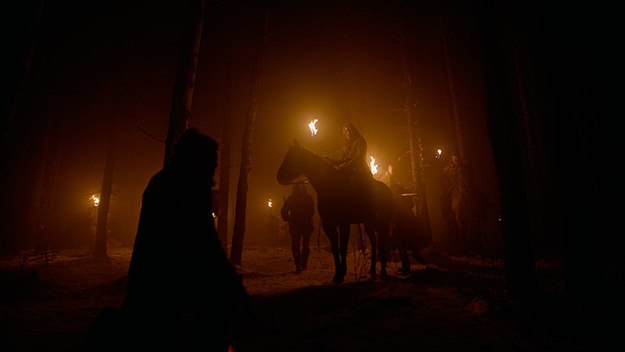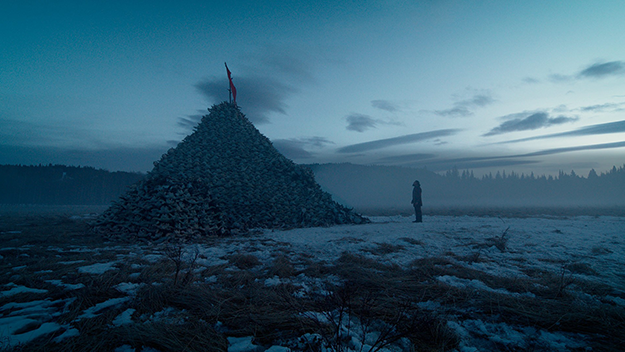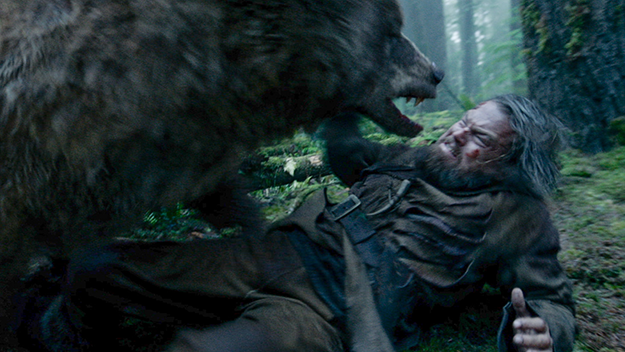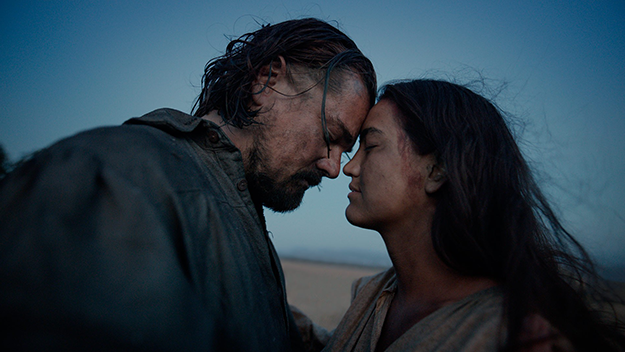Deep Focus: The Revenant

“We are obsessed with technique, hag-ridden by Facts, in love with information,” the seminal cultural critic Dwight Macdonald complained about his fellow Americans 58 years ago. Hollywood, he wrote, “gives us miracles in ‘authenticity’ of costume and furniture, all verified by experts, but doesn’t bother about the authenticity of the human beings who wear the costumes and sit on the period chairs, reversing Marianne Moore’s famous description of the poet as one who creates ‘imaginary gardens with real toads in them.’ (In Hollywood, the gardens are real but the toads are synthetic.)”
The self-consciously experimental director of Birdman (14), Alejandro G. Iñárritu, may be shocked to hear such criticisms leveled at his latest film, The Revenant. But this grueling depiction of cruelty and revenge among pioneer hunters and trappers and Native Americans in the early 19th century is stunningly unimaginative and literal. Iñárritu applies an aesthetic sheen to every aspect of this production and elicits ferocious commitments from his cast, including his star, Leonardo DiCaprio. Still, his determination to catapult audiences into a feral world lacks a visionary pull. He lavishes the most sophisticated cinematic means on the most elemental action, notably an Indian ambush of a base camp for the Rocky Mountain Fur Trading Company and a bone-rattling animal attack that goes on forever. Even the long takes and convoluted camera moves he and cinematographer Emmanuel Lubezki mastered in Birdman, gutsily executed here in the great outdoors, do little more than generate jolts when they aren’t just delivering visual information about the harshness and vastness of primeval landscapes.
The film’s most enduring pleasures are the miraculous lived-in details of Jack Fisk’s production design and Jacqueline West’s costumes. Fisk lays out the trappers’ camp with such richness and intelligence that you perceive it as a sprawling open-air factory for skinning animals and bundling pelts—a mini Industrial Revolution invading the Indian grounds of the American Northwest. And West outfits the people of this region with skins and fabrics that marvelously reflect their diverse backgrounds and eccentricities, giving us a unique melting pot in hides and furs.

Iñárritu and Mark L. Smith base their script on Michael Punke’s eventful historical novel (called The Revenant: A Novel of Revenge) about real-life frontiersman Hugh Glass, who in 1823 crawled and staggered through 200 miles of wilderness to avenge himself on fellow trappers who had abandoned him after a bear grievously mauled him. (“Revenant” means a person who comes back from death or a prolonged absence.) Their adaptation strips down the book’s profusion of incidents and substitutes their own fictional textures. They interweave flashbacks to a devastated Indian village, and they streak the film with New Age lyricism via odd or otherworldly images, like Glass staring at mountains made of buffalo skulls. They give Glass an Indian wife who is dead and a half-Indian son who is alive (for a while, anyway), presumably to expand Glass’s dimensions as a character. At some points, the mysticism gets so thick it’s as if he’s going on a vision quest. But the flights into Native American spirituality aren’t revelatory or exciting, as they are, for example, in Irvin Kershner’s Return of a Man Called Horse. They’re dutiful and hokey. Glass and his boy Hawk (Forrest Goodluck) do convey a quiet emotional closeness—a shared vigilance for each other in a dangerous world. But the actors can’t take it anywhere before Hawk is killed in front of his father’s eyes, by one of the two trappers hired to stay with Glass until he dies.
In this version of the Glass legend, the explorer not only drags his scarred body over ice and rock to seek revenge on those who left him behind. He also exacts retribution for his son. Perhaps Iñárritu thought that to hold the audience’s attention for a 156-minute string of sadistic setpieces, he had to keep the story “primal.” But revenge becomes mind-dulling, not heart-quickening, when it permeates each corner of a movie. It’s as if Iñárritu simply wanted to take the Sicilian proverb, “Revenge is a dish best served cold,” into the extremes of Arctic weather. Even Elk Dog (Duane Howard), a fierce Arikara brave, is searching for a kidnapped daughter. The result is a resonance-free pageant of payback. The final minutes indicate that Glass is ready for some kind of non-violent redemption. You don’t buy that suggestion for a Rocky Mountain second.
Tom Hardy plays Fitzgerald, the cynical trapper who loses his valuables during the Indian raid and accepts $70 to stay with Glass after he’s mauled; Will Poulter plays the virtuous young mountain man Jim Bridger, who also takes the money and stays; and Domhnall Gleeson plays Captain Henry, the stalwart, principled leader of the expedition. The weakest link is Hardy, who makes Fitzgerald such a blatantly shifty and loathsome character that you can’t believe Gleeson’s intelligent Henry would trust him to guard Glass near the beginning or surrender to the Captain near the end. Poulter gives the most credible supporting performance as the youth who sees through Fitzgerald’s self-justifying roguery but lacks the strength or authority to quash his evil plans. Poulter proves to be a master of mortification when Bridger emanates shame and failure over his inability to do what’s right.

As for the movie’s lead: Robert Towne once defined a star as someone who can make a large audience feel what he or she is feeling. When DiCaprio is on screen, you can’t take your eyes off him. DiCaprio is still a star in The Revenant, though all we get out of him is anguish, vengeance, and confusion. He conjures a connection with the audience via urgency alone. But it’s not enough to save the movie.
Shooting only in natural light and in often hazardous conditions, Iñárritu and Lubezki aim to capture something ineffable about the danger, loneliness, and awe of a white man trekking alone in terra incognita. Defenders of this movie will talk about its “sense of place.” But this film has only a sense of things framed in a world of wonders, like the patched-up keelboat of the trappers, or even Glass’s banged-up anatomy itself—a relentless biological machine fueled by rage. In interviews, the movie’s committed cast and crew keep saying they wanted to achieve not a history lesson but an “immersive” experience. The result is not immersive but assaultive and therefore ultimately numbing.
Iñárritu’s combination of virtuosity and bluntness reduces his film’s absorption with frigid ground and freezing water into another kind of fact-mongering. It’s as if he’s a cinematic Walter Cronkite, saying, “That’s the way it was.” It may be that Iñárritu got so far into the material that he lost perspective. In an interview with Empire he rants against the rapacious capitalism and ecological barbarism of the trappers: “Look at the forests—they turned the fucking trees into fucking tables. They had no respect for the fucking birds and the animals—they killed them and turned them into hats.” Maybe the human beings had to keep their heads warm.

In another interview, DiCaprio has said: “This is a very linear, straightforward, brilliantly simplistic screenplay about a man trying to avenge the death of his son and trying to find redemption—but, along the way, we wanted to find the poetry in-between that.” DiCaprio, brave and honest actor that he is, gives the game away with that statement. Can any screenplay be brilliantly simplistic? And can any production, no matter how inventive, force poetry from a slender, facile script? Responding to negative press about the emotional and financial cost of the difficult shoot, Iñárritu has complained: “I can’t imagine David Lean justifying why he went to the desert to shoot Lawrence of Arabia.” Well, David Lean didn’t have to justify it because he had a dynamic central character who was complex enough to anchor an epic. He also had an eloquent script by Michael Wilson and Robert Bolt.
Iñárritu and Lubezki shoot intricate, prolonged takes while choreographing the actors in sadistic pirouettes. This style is terrific at depicting, early on, an Indian tribe mowing down an armed squadron of trappers with arrows and guns and bladed weapons. The camera moves in fluid yet unpredictable motions that open and tighten like a never-ending noose. But the visual self-consciousness becomes alienating and exhausting. By the end, even scenes as visceral as Indians chasing Glass straight off a cliff work merely as spectacle. You hear nary a “whew,” a “wow,” or a “whee,” because the movie is not just depressing, it’s also depressed. When I saw it, the audience reacted audibly just twice—to a particularly destructive bear hug in the pivotal assault and to an especially vicious slashing during Glass’s climactic mano a mano with Fitzgerald. It’s not a good sign when an epic elicits the kind of jaundiced cheering you hear at subprime action films.
In Iñárritu’s film debut, Amores Perros (00), he seemed to be the rare director who would fulfill the cineaste’s dream of using the camera like a pen to “write” short stories or novels onscreen. In The Revenant, he pours his energy into the creation of a totemic art thing. He is now less engaged with the art of fiction than with what I’ll call artifaction.







